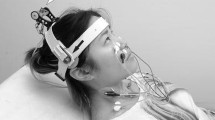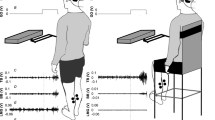Summary
The experiments were designed to test two hypotheses and their corollaries: 1. That adaptation of EMG responses to support surface rotations is due to a decrease in the gain of proprioceptively triggered long-loop stretch reflexes (Nashner 1976), and that the adaptation is dependent on a normally functioning vestibular system (Nashner et al. 1982); 2. That EMG responses to rotations are generated primarily by vestibulo-spinal reflexes triggered by head accelerations (Allum and Pfaltz 1985) and comprise a coactivation of opposing leg muscles (Allum and Büdingen 1979). Adaptation with successive dorsi-flexive rotations of the support surface was investigated in the EMG responses of the ankle muscles, soleus (SOL) and tibialis anterior (TA), as well as the neck muscles, trapezius (TRAP) and splenius capitis (SPLEN CAP), both for normal subjects and for patients with bilateral peripheral vestibular deficit. Both normals and patients who first received the stimulus with their eyes open demonstrated decreasing activation at medium latency (ML), that is, with an onset at about 125 ms, and long latency (LL) responses with an onset ca 200 ms. This was the case for both ankle and neck muscles when the EMG response areas for the first 3 and second 7 of 10 trials were compared. Ankle muscle responses in the patients were diminished in area with respect to normals both with the eyes open and with the eyes closed. Ankle torque recordings from the patients were also smaller in amplitude, and these attenuated differently from normal torque responses. Functional coupling of the opposing ML and LL SOL and TA muscle responses was confirmed by the nearly coincident onset times and significantly correlated EMG response areas. At ML, ankle torque was highly correlated with TA activity when the influence of SOL was controlled. At LL, SOL activity was highly correlated with torque when the influence of TA was controlled. The delay of torque adaptation beyond the period of ML activity in normals, but not in the patients was attributed to the proportionally balanced coactivated muscle patterns producing a consistent force output and level of stability in normals. The results indicate that the adaptation in EMG response amplitudes during a sway stabilisation task is not dependent on a normally functioning vestibular system nor on visual inputs but rather appears to be due to a generalized habituation in the postural control system. Evidence against a change in the gain of proprioceptively triggered long loop reflexes being responsible for adaptation is based on the fact that the adaptation is not restricted to the stretched SOL muscle but includes its agonist, TA, and that the adaptation is not local but also occurs in neck muscles. The results supported the hypothesis that postural reflexes to support surface rotations may well be triggered by stretch reflexes in the lower leg or neck muscles, however, their amplitude modulation is overwhelmingly under the control of vestibulo-spinal signals.
Similar content being viewed by others
References
Allum JHJ (1983) Organization of stabilizing reflex responses in tibialis anterior muscles following ankle flexion perturbations of standing man. Brain Res 264: 297–301
Allum JHJ, Buedingen HJ (1979) Coupled stretch reflexes in ankle muscles: an evaluation of the contributions of active muscle mechanisms to human postural stability. In: Granit R, Pompeiano O (eds) Reflex control of posture and movement, Vol 50. Elsevier/North-Holland, Amsterdam, pp 185–195
Allum JHJ, Mauritz KH (1984) Compensation for intrinsic muscle stiffness by short-latency reflexes in human triceps surae muscles. J Neurophysiol 52: 797–818
Allum JHJ, Pfaltz CR (1985) Visual and vestibular contributions to pitch sway stabilization in the ankle muscles of normals and patients with bilateral peripheral vestibular deficits. Exp Brain Res 58: 82–94
Bendat JS, Piersol AG (1971) Random data: analysis and measurement procedures. Wiley, New York
Bizzi E, Chapple W, Hogan N (1982) Mechanical properties of muscles. Trends Neurosci 5: 395–398
Black FO, Wall III C, Nashner LM (1983) Effects of visual and support surface orientation references upon postural control in vestibular deficient subjects. Acta Otolaryngol 95: 199–210
Bussel B, Katz R, Pierrot-Deseilligny E, Bergego C, Hayat A (1980) Vestibular and proprioceptive influences on the postural reactions to a sudden body displacement in man. In: Desmedt JE (ed) Spinal and supraspinal mechanisms of voluntary motor control and locomotion. Prog Clin Neurophysiol, Vol. 8. Karger, Basel, pp 310–322
Collins WE (1973) Habituation of vestibular responses with and without visual stimulation. In: Kornhuber HH (ed) Handbook of sensory physiology, Vol 6. Springer, New York, pp 369–388
Diener HC, Bootz F, Dichgans J, Bruzek W (1983) Variability of postural reflexes in humans. Exp Brain Res 52: 423–428
Diener HC, Dichgans J, Bootz F, Bacher M (1984a) Early stabilization of human posture after a sudden disturbance: influence of rate and amplitude of displacement. Exp Brain Res 56: 126–134
Diener HC, Dichgans J, Bacher M, Guschlbauer B (1984b) Characteristic alterations of long-loop “reflexes” in patients with Friedreich's disease and late atrophy of the cerebellar anterior lobe. J Neurol Neurosurg Psychiat 47: 679–685
Diener HC, Dichgans J, Guschlbauer B, Mau H (1984c) The significance of proprioception on postural stabilization as assessed by ischemia. Brain Res 296: 103–109
Fel'dman AG (1966) Functional tuning of the nervous system with control of movement or maintenance of a steady posture. II. Controllable parameters of the muscles. Biofizika 11: 498–508
Fel'dman AG (1981) The composition of central programs subserving horizontal eye movements in man. Biol Cybern 42: 107–116
Gielen CCAM, Van Zuylen EJ (1986) Coordination of arm muscles during flexion and supination: application of the tensor analysis approach. Neuroscience 17: 527–539
Horak FB, Nashner LM (1986) Central programming of postural movements: adaptation to altered support-surface configurations. J Neurophysiol 55: 1369–1381
Kasai T, Zee DS (1978) Eye-head coordination in labyrinthine-defective human beings. Brain Res 144: 123–141
Lestienne F, Soechting J, Berthoz A (1977) Postural readjustments induced by linear motion of visual scenes. Exp Brain Res 28: 363–384
Myers JL (1979) Fundamentals of experimental design. Allynand Bacon Inc, Boston, pp 459–484
Nashner LM (1972) Vestibular postural control model. Kybernetik 10: 106–110
Nashner LM (1976) Adapting reflexes controlling the human posture. Exp Brain Res 26: 59–72
Nashner LM, Berthoz A (1978) Visual contribution to rapid motor responses during postural control. Brain Res 150: 403–407
Nashner LM, Woollacott M, Tuma G (1979) Organization of rapid responses to postural and locomotor-like perturbations of standing man. Exp Brain Res 36: 463–476
Nashner LM, Black FO, Wall III C (1982) Adaptation to altered support and visual conditions during stance: patients with vestibular deficits. J Neurosci 2: 536–544
Peterson BW, Goldberg J, Bilotto G, Fuller JH (1985) Cervicocollic reflex: its dynamic properties and interaction with vestibular reflexes. J Neurophysiol 54: 90–109
Stein RB, Bawa P (1976) Reflex responses of human soleus muscle to small perturbations. J Neurophysiol 39: 1105–1116
Viviani P, Berthoz A (1975) Dynamics of the head-neck system in response to small perturbations: analysis and modeling in the frequency domain. Biol Cybern 19: 19–37
Wereley N, Guitton D, Kearney RE, Peterson BW (1983) Visual, vestibular and voluntary contributions to human head stabilization. Neurosci Abstr 9: 67
Woollacott MH, Keshner E (1984) Upper body responses to postural perturbations in man. Neurosci Abstr 10: 635
Young LR, Henn VS (1974) Selective habituation of vestibular nystagmus by visual stimulation. Acta Otolaryngol 77: 159–166
Author information
Authors and Affiliations
Rights and permissions
About this article
Cite this article
Keshner, E.A., Allum, J.H.J. & Pfaltz, C.R. Postural coactivation and adaptation in the sway stabilizing responses of normals and patients with bilateral vestibular deficit. Exp Brain Res 69, 77–92 (1987). https://doi.org/10.1007/BF00247031
Received:
Accepted:
Issue Date:
DOI: https://doi.org/10.1007/BF00247031




